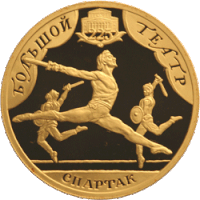Spartacus (ballet)
| Spartacus | |
|---|---|
 | |
| Choreographer | Leonid Yakobson |
| Music | Aram Khachaturian |
| Premiere | 1956 Kirov Theatre, Leningrad |
| Original ballet company | Kirov Ballet |
| Characters |
|
| Genre | Neoclassical ballet |

Spartacus (Template:Lang-ru) is a ballet by Aram Khachaturian (1903–1978). The work follows the exploits of Spartacus, the leader of the slave uprising against the Romans known as the Third Servile War, although the ballet's storyline takes considerable liberties with the historical record. Khachaturian composed Spartacus in 1954, and was awarded a Lenin Prize for the composition that same year.[1] It was first staged, with choreography by Leonid Yakobson, in Leningrad 1956,[2] but only with qualified success since Yakobson abandoned conventional pointe in his choreography.[3] The ballet received its first staging at the Bolshoi Theatre, Moscow in 1958, choreographed by Igor Moiseyev; however it was the 1968 production, choreographed by Yury Grigorovich, which achieved the greatest acclaim for the ballet.[2] It remains one of Khachaturian's best known works and is prominent within the repertoires of the Bolshoi Theatre and other ballet companies in Russia and the former Soviet Union.
Synopsis
Principal Characters:
- Crassus, Roman consul
- Spartacus, captive king of Thrace
- Phrygia, wife of Spartacus
- Aegina, concubine to Crassus
Act I
The Roman consul Crassus returns to Rome from his latest conquests in a triumphal procession. Among his captives are the Thracian king Spartacus and his wife Phrygia. Spartacus laments his captivity and bids a bitter farewell to Phrygia, who is taken off to join Crassus’ harem of concubines. To entertain Crassus and his entourage, Spartacus is sent into the gladiatorial ring and is forced to kill a close friend. Horrified at his deed, Spartacus incites his fellow captives to rebellion.
Act II
The escaped captives celebrate their freedom. Meanwhile, Crassus entertains the Roman patricians with a lavish entertainment, including fights between blindfolded gladiators, one of whom is Spartacus. Spartacus unknowingly kills his friend in the arena. This induces Spartacus and his men to rebel. They disrupt the orgy and rescue the slave women, including Phrygia. Aegina insists that Crassus pursue the slave army immediately. The lovers celebrate their escape to the "Adagio of Spartacus and Phrygia".
Act III
Aegina discovers Spartacus’s camp and observes the lovers emerging from their tent the next morning. Aegina sends word to Crassus, who sends his army in pursuit. Internecine struggles break out among Spartacus’s forces. Finally, Crassus’s forces discover Spartacus and impale him upon their spears. Spartacus’s closest followers recover his body and carry it off while Phrygia mourns her loss.
Orchestral adaptation
Khachaturian extracted and arranged music from the ballet in 1955 for four orchestral suites:
- Spartacus Suite No.1
- Introduction - Dance of the Nymphs
- Adagio of Aegina and Harmodius
- Variation of Aegina and Bacchanalia
- Scene and Dance with Crotala
- Dance of the Gaditanae - Victory of Spartacus
- Spartacus Suite No.2
- Adagio of Spartacus and Phrygia
- Entrance of the Merchants - Dance of a Roman Courtesan -
- General Dance
- Entrance of Spartacus - Quarrel -
- Treachery of Harmodius
- Dance of the Pirates
- Spartacus Suite No.3
- Dance of a Greek Slave
- Dance of an Egyptian Girl
- Night Incident
- Dance of Phrygia - Parting Scene
- At the Circus
- Spartacus Suite No.4
- Bacchante's Melancholy Dance
- Spartacus Procession
- Death of the Gladiator
- Call to Arms - Spartacus' Uprising
- Instrumentation
2 flutes, 2 oboes, 2 clarinets, 2 bassoons; 4 horns, 4 trumpets, 3 trombones, tuba; timpani, percussion ; strings.
In popular culture
- Ashley Wagner won the 2015 U.S. Figure Skating Championships with her short program to this music.
- Part of the Adagio of Spartacus and Phrygia (the opening piece in Suite No. 2) was used as the opening theme for the British television series The Onedin Line.
- Part of the "Adagio of Spartacus and Phrygia" was also used in the film Caligula (1979). A disco version of this theme with lyrics by the artist Lydia was also released as a single from the soundtrack. (http://www.caligulathemovie.com/music.html)
- This segment was also used as the main love theme in the film Mayerling, and in The Hudsucker Proxy.
- It was also featured in the 2006 animated film Ice Age: The Meltdown, and again in the film's sequel, Ice Age: Dawn of the Dinosaurs.
- Oksana Domnina and Maxim Shabalin won the 2009 World Figure Skating Championships Ice Dance competition with their free dance to the music.
- In 2004, Ukrainian rhythmic gymnast Anna Bessonova performed her bronze medal ball routine at the Athens Olympics to an excerpt of the adagio.
- In 1984, with words by Tony Hiller and Nicky Graham, it became a popular song, Journey's End, recorded by Andy Williams on Capitol.
- Portions of the ballet were performed by the Phantom Regiment Drum and Bugle Corps in 1981, 1982, and 2008 - with the Corps winning the 2008 DCI World Championship title, performing their interpretation of the ballet.[4]
